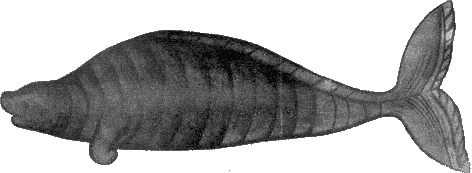- Evolution of Sirenia PDF
- Rothauscher
- Ari Lampinen
- Fossil Seacows
- Geological Time
- University of Michigan
- UNEP WCMC
- ITIS Report
- French Fossils
Visit Sirenian Fossils
- Metaxytherium crataegense at the Calvert Marine Museum
- Metaxytherium floridanum and Hydrodamalis gigas at the Smithsonian's National Museum of Natural History
- Hydrodamalis cuestae at the San Diego Natural History Museum
- Halitherium taulannense at La R�serve G�ologique de Haute Provence
- Dusisiren jordani at the Santa Cruz Museum of Natural History
Steller's SeaCow Hydrodamalis gigas
Home | Distribution Map | Amazonian Manatee | West Indian Manatee | West African Manatee | Dugong | Steller's Seacow
Discovered 1741
Extinct 1768

This Sketch of Steller's sea cow is from the journal of Sven Waxell, "Kamchatka Expedition 1741-1742"; source: The American Expedition by Sven Waxell 1952.
Hydrodamalis gigas, formerly classified as Rytina gigas, was first seen by modern humans when Captain Vitus Bering and his comrades discovered an uninhabited island (later named Bering Island) in 1741. Bering and his two ships, St. Peter and St. Paul, were on their way home to Kamchatka following an expedition to map the coast of Alaska for Tsar Peter I the Great of Russia. The ships were separated during a storm and Captain Bering, the St. Peter, and her crew were stranded on the island. Although Bering died on the island during the winter of 1741, Georg Wilhelm Steller (a German-born naturalist), and about half of the ship's crew survived to rebuilt their ship and return home in 1742, thanks to the meat of the sea cow.
In his writings, Steller described the giant sea cow and its habits, but was vague in his accounts of abundance and distribution. He said he found it numerous and in herds, leaving future researchers to guess at exactly how many. Stejneger (1887) estimated the number at less than 1500 and hypothesized that they were the last survivors of a once more numerous and widely distributed species which had been spared because man had not yet reached their last resort. Modern scientists agree that Steller's sea cow, and it's ancestors, H. cuestae, Dusisiren dewana, and D. jordani, were once widely distributed around the Pacific rim from Baja to Japan, where Hydrodamalis thrived until the coming of humans in the Pleistocene (Domning 1987).
Upon the St. Peter's return to Kamchatka in 1742, word of the excellent sea cow meat spread quickly through the sailing community. New hunting expeditions were formed almost every year. They returned to Bering Island where they spent 8-9 months hunting fur-animals and eating sea cow meat to survive. Indeed, many of the expeditions are reported to have wintered on Bering Island for the express purpose of collecting sea cow meat for the remainder of their 3-4 year journey to the Aleutian Islands and America. The last sea cow was reported killed in 1768, just 27 years after the island had been discovered by modern man.
From Steller's description, these huge herbivores are believed to have numbered around 1500-2000 in the Bering Island and Copper Island areas of the North Pacific (circa 1741). The largest animals were 4-5 fathoms long (1 fathom = 6 feet), 3.5 fathoms thick around, and weighed 200 puds or 80 short hundredweight (up to about 8,000 pounds). They had no teeth, but two flat white bones, the one above fixed to the palate, and the one below on the inside of the lower jaw. Both were furrowed and had raised ridges with which they masticated kelp.
The sea cows were found in herds close to shore. They drifted just below the surface of the water, a single animal resembled an overturned boat. Steller and Waxell both noted large midsections and very small heads. To see a photograph of the skeleton of a Steller's sea cow in the Helsinki Museum, go to Ari Lampinen, University of Jyvaskyla, Finland. The text is in Finnish, but the photo is worth the trip!
The ancestor to Steller's Sea Cow was possibly an extinct Dugongidae sea cow, Dusisiren jordani, previously named Metaxytherium jordani. Dusisiren was common in the shallow coastal waters of late Miocene California 10-12 million years ago. Although Sirenian evolution is not fully understood, there is a very clear and compelling fossil record leading up to Steller's sea cow (Domning 1987).
Scientists believe the Order Sirenian originated near Africa in the middle Eocene, 45-50 MYBP (Perry 1995; also see Domning, D. P., 1978, Sirenian Evolution in the North Pacific Ocean, University of California Press). Click to learn more about the Eocene and Geological Time.
References
- Domning, D. P. 1987. Sea cow family reunion. Natural History April 1987 Vol.96(4):64-71.
- Stejneger, Leonhard. 1887. How the great northern sea-cow (Rytina) became exterminated. The American Naturalist 21(12):1047-1054.
- Steller, Georg Wilhelm. 1988. Journal of a Voyage with Bering 1741-1742. Stanford University Press. Stanford, California. 252 pp.
- Waxell, Sven. 1952. The American Expedition. William Hodge and Company, Limited. London. 236 pp.
READ MORE ABOUT IT! To read more about Paleosirenians, do a literature search in our Bibliography for Domning. Dr. Daryl P. Domning, Howard University, Washington, DC, is quite possibly the world's foremost authority on sirenian evolution.


